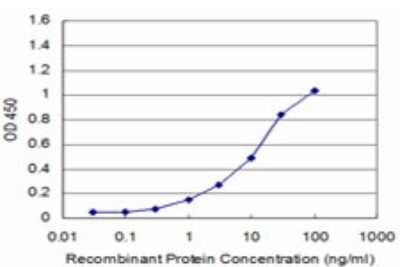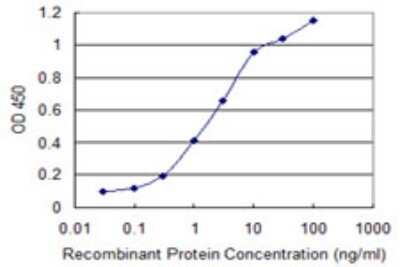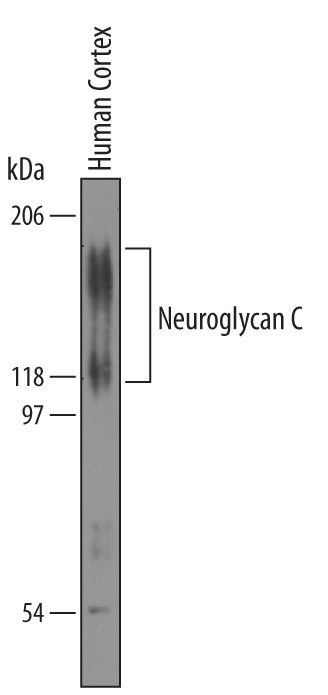Neuroglycan C/CSPG5 Products
Neuroglycan C (NGC; also CSPG5 and CALEB) is a 120-150 kDa type I transmembrane glycoprotein and member of the neuregulin family of proteins. Depending on its expression profile, NGC may be a glycoprotein of 120 kDa, or a chondroitin sulfate (CS) proteoglycan of 150 kDa. Mouse NGC is synthesized as a 566 amino acid (aa) precursor that contains a 30 aa signal sequence, a 393 aa extracellular domain (ECD), a 21 aa transmembrane segment, and a 122 aa cytoplasmic region. The ECD contains one CS attachment domain (aa 32-273), with CS attachment at Ser117, one EGF-like domain (aa 371-413), three potential sites for N-linked glycosylation, and ten potential sites for O-linked glycosylation. Splicing variants produce four isoforms for human NGC. Isoform 1 is the standard form. Isoform 2 has a deletion of aa 487-513, while isoform 3 has an alternative start site at Met82 and the same deletion. Isoform 4 has a 56 aa substitution for aa 514-566. Phosphorylation likely occurs at Ser249, and proteolysis generates a 75 kDa soluble fragment. Over aa 31-420, mouse NGC shares 84% aa identity with human NGC. NGC is expressed in nervous tissue and is found on retinal ganglion cells, cerebellar Purkinje cells and hippocampal neurons. NGC may function as a growth and differentiation factor involved in neuritogenesis. One study shows that the recombinant ectodomain of NGC core protein enhances neurite outgrowth from rat neocortical neurons in culture via phosphatidylinositol 3-kinase and protein kinase C signaling pathways. Another study states that NGC is a novel component of midkine receptors, a heparin-binding growth factor that promotes cell attachment and process extension in oligodendroglial precursor-like cells. NGC also acts as a growth factor by directly binding ErbB3 tyrosine kinase and transactivating ErbB2.
11 results for "Neuroglycan C/CSPG5" in Products
11 results for "Neuroglycan C/CSPG5" in Products
Neuroglycan C/CSPG5 Products
Neuroglycan C (NGC; also CSPG5 and CALEB) is a 120-150 kDa type I transmembrane glycoprotein and member of the neuregulin family of proteins. Depending on its expression profile, NGC may be a glycoprotein of 120 kDa, or a chondroitin sulfate (CS) proteoglycan of 150 kDa. Mouse NGC is synthesized as a 566 amino acid (aa) precursor that contains a 30 aa signal sequence, a 393 aa extracellular domain (ECD), a 21 aa transmembrane segment, and a 122 aa cytoplasmic region. The ECD contains one CS attachment domain (aa 32-273), with CS attachment at Ser117, one EGF-like domain (aa 371-413), three potential sites for N-linked glycosylation, and ten potential sites for O-linked glycosylation. Splicing variants produce four isoforms for human NGC. Isoform 1 is the standard form. Isoform 2 has a deletion of aa 487-513, while isoform 3 has an alternative start site at Met82 and the same deletion. Isoform 4 has a 56 aa substitution for aa 514-566. Phosphorylation likely occurs at Ser249, and proteolysis generates a 75 kDa soluble fragment. Over aa 31-420, mouse NGC shares 84% aa identity with human NGC. NGC is expressed in nervous tissue and is found on retinal ganglion cells, cerebellar Purkinje cells and hippocampal neurons. NGC may function as a growth and differentiation factor involved in neuritogenesis. One study shows that the recombinant ectodomain of NGC core protein enhances neurite outgrowth from rat neocortical neurons in culture via phosphatidylinositol 3-kinase and protein kinase C signaling pathways. Another study states that NGC is a novel component of midkine receptors, a heparin-binding growth factor that promotes cell attachment and process extension in oligodendroglial precursor-like cells. NGC also acts as a growth factor by directly binding ErbB3 tyrosine kinase and transactivating ErbB2.
| Source: | CHO |
| Accession #: | AAQ04774 |
| Applications: | BA |
| Source: | CHO |
| Accession #: | AAH55736 |
| Applications: | BA |
| Reactivity: | Human |
| Details: | Mouse IgG1 kappa Monoclonal Clone #5C11 |
| Applications: | WB, ELISA |
| Reactivity: | Human |
| Details: | Rabbit IgG Polyclonal |
| Applications: | IHC |
| Reactivity: | Human |
| Details: | Rabbit IgG Polyclonal |
| Applications: | WB |
| Applications: | AC |
| Applications: | AC |
| Reactivity: | Human |
| Details: | Mouse IgG1 kappa Monoclonal Clone #4G6 |
| Applications: | WB, ELISA |
| Reactivity: | Human |
| Details: | Rabbit IgG Polyclonal |
| Applications: | ICC/IF |
| Reactivity: | Mouse, Rat |
| Details: | Goat IgG Polyclonal |
| Applications: | WB, IHC |
| Reactivity: | Human |
| Details: | Sheep IgG Polyclonal |
| Applications: | WB, IHC |




![Immunohistochemistry-Paraffin: Neuroglycan C/CSPG5 Antibody [NBP2-49669] Immunohistochemistry-Paraffin: Neuroglycan C/CSPG5 Antibody [NBP2-49669]](https://resources.bio-techne.com/images/products/Neuroglycan-C-CSPG5-Antibody-Immunohistochemistry-Paraffin-NBP2-49669-img0004.jpg)
![Western Blot: Neuroglycan C/CSPG5 Antibody [NBP1-59341] Western Blot: Neuroglycan C/CSPG5 Antibody [NBP1-59341]](https://resources.bio-techne.com/images/products/Neuroglycan-C-Antibody-Western-Blot-NBP1-59341-img0002.jpg)

![Immunocytochemistry/ Immunofluorescence: Neuroglycan C/CSPG5 Antibody [NBP2-58590] Immunocytochemistry/ Immunofluorescence: Neuroglycan C/CSPG5 Antibody [NBP2-58590]](https://resources.bio-techne.com/images/products/Neuroglycan-C-CSPG5-Antibody-Immunocytochemistry-Immunofluorescence-NBP2-58590-img0001.jpg)

